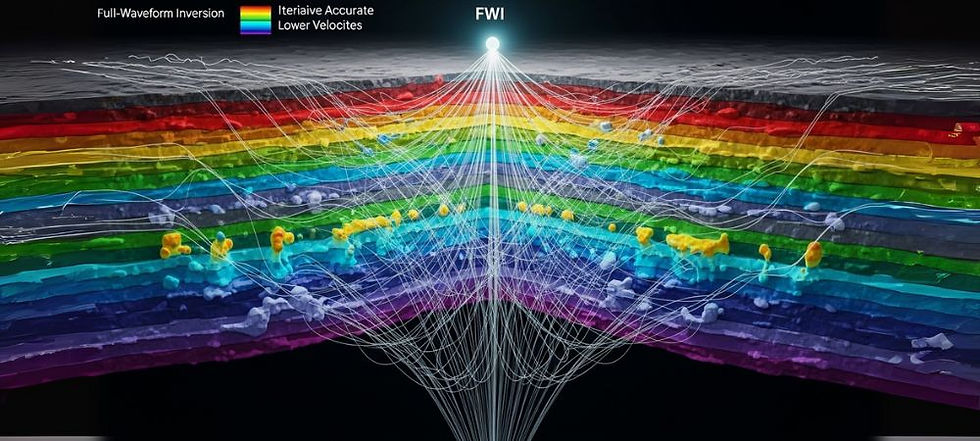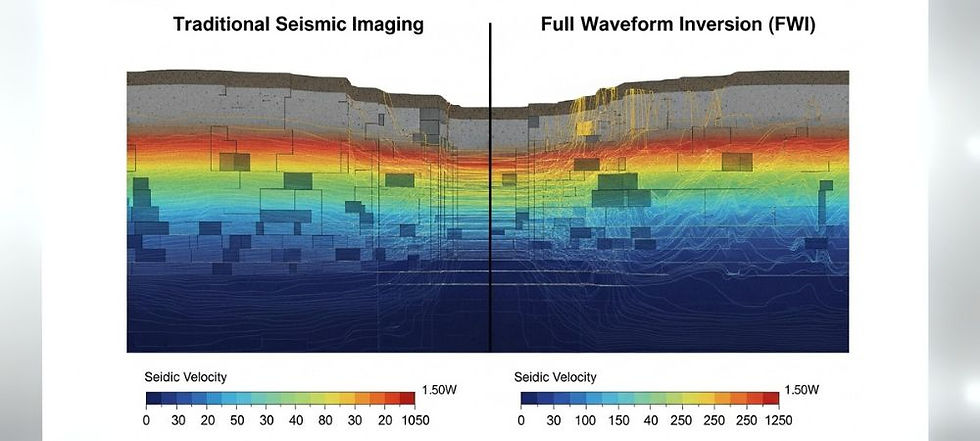An Ultimate Guide to Full-Waveform Inversion (FWI)
- abid riaz
- Aug 10
- 7 min read
What is Full-Waveform Inversion (FWI)?

A High-Resolution Seismic Imaging Technique
An introduction to full waveform inversion has offered geoscientists a revolutionary approach to seismic exploration. Unlike traditional imaging methods, an overview of full waveform inversion in exploration geophysics shows that this technique is able to extract detailed subsurface properties through the use of full seismic waveform modelling and inversion. Through FWI, we are able to capture the full complexity of seismic wave propagation, resulting in High-resolution seismic imaging that shows subtle geological features which are often missed by conventional workflows.
Core Principles: Moving Beyond Conventional Methods
FWI is based on the principle of waveform inversion: a method through which recorded seismic data is analysed alongside synthetic data created through a process of physics-based modeling. Through this comparison, we can view iterative updates to the Earth model, ultimately yielding a thoroughly accurate velocity profile. Rather than simplifying wave travel paths as done in ray-based methods, FWI seismic analysis resolves the full wave equation, making it a great deal more sensitive to true waveforms and geological variations.
How FWI Utilizes the Full Seismic Wavefield
To understand what full-waveform inversion is in geophysics, It's vital to appreciate how FWI is able to control the complete seismic wavefield. Every part of the wave, whether transmitted, reflected, refracted, or scattered, contains crucial information. By integrating all of these components of a wave through full seismic waveform modelling and inversion, FWI constructs a clearer picture of the subsurface. This results in more accurate models that are particularly useful for subsurface imaging in a complex geological setting.
The FWI Workflow: From Data to Image
Step 1: Seismic Data Acquisition and Preparation
The FWI workflow starts with acquiring high quality seismic data, which consists of:
●Broadband acquisition to ensure low and high frequency content
●Wide-azimuth surveys to capture diverse wave propagation paths
●Use of acquisition types like streamer, ocean-bottom nodes (OBN), land-based, and 2D, 3D, or 4D geometries
Conducting preprocessing steps such as source estimation, deghosting, and noise suppression ensures optimal input data for the inversion process.
Step 2: Forward Modeling and Synthetic Data
Forward modeling is essential for generating synthetic waveforms based on an initial velocity model. Through a comparison with real data, FWI determines residuals that guide the model update. This step is a crucial part of the Waveform inversion techniques.
Step 3: Iterative Inversion and Model Updating
The synthetic and observed data are brought closer together, and any misfit is reduced through each cycle of the process. FWI uses optimization methods, such as gradient descent and Hessian-based updates, to improve the velocity model with each iteration.
For any projects that use seismic full-waveform inversion using deep learning tools and techniques, AI is a helpful tool that can be used to speed up and refine this iterative process.
Step 4: Quality Control and Final Velocity Model
Throughout the process, quality checks are repeatedly performed. Analysts assess convergence trends, cross-compare with other geophysical data, and assess model reliability. The resulting outcome is a thorough and geologically consistent velocity model that is ready for interpretation or migration.
Key Benefits of Using FWI in Seismic Projects
Unprecedented Image Resolution and Detail
One of the more notable Benefits of FWI for oil and gas exploration is its capacity to reveal intricate geological features with remarkable clarity. This enhanced resolution can de-risk drilling operations and assist in identifying potential hydrocarbon zones.
Improved Accuracy in Complex Geological Settings (Sub-salt, Carbonates)
FWI is able to outperform traditional imaging techniques, especially in a challenging environment. Such as salt bodies or fractured carbonates. It is able to simulate a full wavefield here, while ray-based methods often fail to work due to complex wave behavior.
Enhanced Illumination by Modeling More of the Wavefield
Through accounting for all seismic energy, including multiple scattered waves, FW is able to provide better illumination of geological features, particularly in shadow zones where traditional methods are scarce in coverage.
Better Identification of Shallow Hazards and Reservoir Characterization
Unprecedented Image Resolution and Detail
○One of the more notable Benefits of FWI for oil and gas exploration is its capacity to reveal fine-scale subsurface features
○Enhances hydrocarbon identification and de-risking
Improved Accuracy in Complex Geological Settings
○Effective under salt bodies, fractured carbonates, and thrust belts
○Accurately models complex wave phenomena
Enhanced Illumination
○Models full wavefield, including multiples and scattered waves
○Improves subsalt and structurally complex zone imaging
Better Shallow Hazard Detection & Reservoir Characterization
○Is able to identify shallow hazards critical to drilling
○Improves deep reservoir insights through elastic properties
Comparing FWI to Traditional Seismic Imaging Methods

FWI vs. Ray-Based Tomography
While FWI uses the full waveform and allows for greater insight and higher resolution across depths, Ray-based tomography simplifies seismic propagation into straight-line paths and relies mainly on traveltime data.
FWI vs. Reverse Time Migration (RTM)
Method | Wavefield Used | Model Updating | Best Use Case | Limitation |
FWI | Full wavefield (reflections, refractions, multiples) | Iterative inversion(gradient-based, Hessian) | Complex subsurface, under salt, carbonates, thrust belts | High computational demand requires a good starting model |
Ray-Based Tomography | First Arrivals (Travel time) | Linearized, global updates | large-scale velocity trends | Misses small-scale features, oversimplifies wave propagation |
RTM | Reflections(mostly) | No inversion; uses predefined velocity model | Imaging steep dips and complex structures | Relies onan accurate velocity model; doesn’t refine it |
Conventional Migration | Reflections | Fixed velocity models | Basic structural imaging | Not suitable for highly complex areas |
Why FWI Delivers Superior Results in Complex Geology
How does FWI improve seismic imaging? The answer lies in its ability to resolve fine-scale variations in velocity. FWI maintains accuracy, whether beneath salt, in fractured zones, or across unconformities, where traditional techniques generally falter.
Exploring Different Types of Full-Waveform Inversion
Acoustic FWI
Acoustic FWI simplifies the physics by focusing only on P-wave (compressional wave) propagation. It is a computationally efficient choice for building initial velocity models and is widely used in marine settings, where S-waves are not readily transmitted through the water column.
Core Principle: Models the subsurface using the acoustic wave equation, primarily solving for P-wave velocity.
Common Applications: Ideal for marine streamer and Ocean Bottom Node (OBN) data, particularly for salt body imaging and initial velocity model building.
Elastic FWI
Elastic FWI provides a more complete picture of the subsurface by modeling the propagation of both P-waves and S-waves (shear waves). This dual-wave approach offers a richer characterization of the earth's properties, which is critical for detailed reservoir analysis.
Core Principle: Incorporates both P-wave and S-wave data using the elastic wave equation, allowing it to solve for multiple parameters like P-wave velocity, S-wave velocity, and density.
Common Applications: Essential for land seismic data and complex reservoirs where rock properties (lithology, porosity, fluid content) are linked to both P- and S-wave velocities.
Time-Lag FWI (TLFWI) for Overcoming Cycle-Skipping
Time-Lag FWI is an advanced technique designed to overcome cycle-skipping—a major pitfall in conventional FWI that occurs when the initial model is too inaccurate or low-frequency data is missing. Instead of directly comparing the amplitudes of seismic waveforms, TLFWI focuses on their timing. It measures the time shift between the observed and predicted data, often using a cross-correlation function. The inversion process then aims to minimize this time lag, ensuring the travel times are correct before fine-tuning the waveform's shape.
Core Principle: Modifies the objective function to minimize the time shifts (kinematic errors) between waveforms rather than their point-by-point amplitude differences (dynamic errors).
Common Applications: Mitigates cycle-skipping, making it highly effective when a good starting model is unavailable or when the dataset lacks the crucial low-frequency information needed for conventional FWI to succeed.
Common Challenges and Solutions in FWI Implementation
Lack of Low-Frequency Data and Cycle-Skipping
When there is a risk of cycle-skipping, low frequencies guide the inversion toward large-scale features. When such data is missing, strategies like time-lag methods or AI-driven waveform matching become critical.
High Computational Cost and HPC Requirements
Access to high-performance computing (HPC) infrastructure is often necessary as FWI is computationally demanding. By using Cloud-based solutions and parallel processing techniques, these barriers can be reduced.
Choosing the Right Starting Velocity Model
● Challenges:
○ A Lack of Low-Frequency Data
○ Risk of Cycle-Skipping
○ High Computational Cost
○ Dependency on Initial Model Quality
● Solutions:
○ Use of time-lag FWI or low-frequency enhancement techniques
○ Utilizing cloud computing and parallel processing
○ Better initial models using tomography, geophysical consulting, or RTM-based model building.
The Future of Subsurface Imaging with FWI
Integration with Machine Learning and AI
As seismic full-waveform inversion using deep learning tools and techniques advances, the combination of FWI with AI promises faster, smarter, and more automated inversion workflows.
Advancements in Elastic and Anisotropic FWI
As more research is being conducted about elastic full waveform inversion and anisotropic modeling, the scope of what FWI can achieve is expanding drastically. These advancements will be particularly valuable in complex geological and geomechanical settings.
Making FWI More Accessible for Diverse Projects
Through higher advancements in computing and software, FWI is no longer only used for major offshore projects. FWI is becoming increasingly available and versatile, from Subsurface imaging in geothermal fields to CCS and mineral exploration.
EIFGeosolutions: Your Partner in Advanced Seismic Imaging
Our Expertise in FWI and High-End Technology
At EIFGeosolutions, we’ve invested deeply in advanced Seismic imaging techniques, including FWI. Our team particularly specializes in applying cutting-edge inversion strategies to produce more detailed and reliable subsurface models for every geological challenge.
Case Studies: How We've Solved Complex Imaging Challenges
Our FWI-driven projects have enabled more accurate exploration decisions as well as improved drilling success rates and reduced operational risks from imaging beneath thick salt to resolving carbonate heterogeneity.
Contact Us for Your Next Seismic Project
Let’s work together on your next seismic survey. Whether you are interested in conventional imaging or full-fledged FWI modeling, EIFGeosolutions has the experience and technology to assist you in achieving the clearest view of the subsurface.
FAQs
Q. What makes Full-Waveform Inversion (FWI) different from traditional seismic imaging?
Unlike conventional methods that rely mainly on first-arrival travel times, FWI uses the entire seismic wavefield—including reflections, refractions, and multiples—to produce much higher-resolution velocity models.
Q. Is FWI only useful in offshore exploration, or can it be applied onshore as well?
FWI is widely used offshore, especially in challenging subsalt environments, but it’s also increasingly applied in onshore projects where complex geology requires greater imaging accuracy.
Q. Why is low-frequency data so important for FWI?
Low frequencies help avoid cycle-skipping, which occurs when the inversion process aligns the wrong wave cycles between observed and synthetic data. They provide a stable foundation for building accurate velocity models.
Q. What are the main challenges of implementing FWI?
The biggest challenges include the need for ultra-low-frequency data, high computational costs that require advanced HPC infrastructure, and the selection of a reliable starting velocity model.
Q. How is the future of FWI evolving?
The future of FWI lies in its integration with machine learning, improvements in elastic and anisotropic modeling, and innovations that reduce computing costs—making it more accessible for a wider range of seismic projects.


Comments